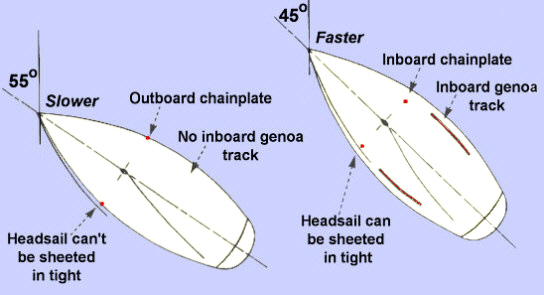| QUESTION: What is the advantage in having inboard genoa tracks and chainplates? | ||
| ANSWER: There is a substantial advantage when going to windward. An advantage because the headsail can be sheeted in tighter. This allows the hull to be pointed closer to the wind direction. A tacking angle that takes full advantage of the optimum 12% thickness NACA foil keel. The ability to point higher results in a greater VMG (Velocity Made Good: Resultant speed directly toward windward destination). | ||
|
Advantage of Inboard Genoa Tracks and Chainplates |
||
|
Without Inboard Hardware Tacking angle 100 to 110 degrees. May foot slightly faster but overall VMG is substantially reduced by up to 30%. |
|
With Inboard Hardware Tacking angle 85 to 90 degrees results in higher pointing ability with resultant VMG as high as 30% greater. |
|
|
||
| From "Modern Cruising Under Sail" by Don Dodds | ||
| “The tighter the headsail can be sheeted in, the closer to the wind the boat can sail, especially in winds of less than about 12 knots (Marchaj, Aero-Hydrodynamics). Obviously the sail can only be sheeted in until it contacts the shrouds. When it does so depends on the sail’s curvature, how high its foot is off the deck (since the shrouds angle inboard as they rise), and the position of the shroud chainplate. The first two items are variable, but the position of the chainplate is fixed and therefore will determine how close to the wind the boat can be sailed in light air.” | ||
| From “Further Offshore: A Practical Guide for Sailors” by Ed Mapes | ||
| “Chainplates attached to the outside of the hull are more likely to cause leaks and, by forcing the jib’s sheeting angle outboard, reduce upwind sailing efficiency.” | ||
